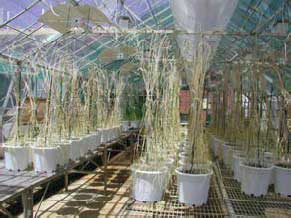New South Wales, Australia
December 6, 2005
Source:
New South Wales Department
of Primary Industries
Organic Newsletter Volume 2, issue 9, Sept-Nov 2005
|
 |
|
The ‘Cootamundra’ spelt
selectiongrowing at NSW DPI’s Certified OrganicSite at
Yanco Agricultural Institute. |
Spelt is currently an important
component oforganic rotations in Australia’s winter
rainfallzones. In Australia, organic spelt is currentlyprocessed
for flour and further value-added intobread, licorice, spelt
flakes, and pasta. In addition,spelt has benefits for livestock,
both for grazingand as a stock feed supplement.
Environmentally,spelt is well adapted to organic systems. In
additionto having lower nutritional requirements thanwheat,
anecdotal evidence suggests that spelt wasunaffected by stripe
rust in 2004 when the diseasewas widespread throughout Australia
and appearsmore tolerant of waterlogging and salt (GroundCover,
Issue 55, April/May, GRDC 2005).
The seeming adaptability of spelt
suggests that itmay have a role to play in Australian
agricultural systems as climate change impacts on traditional
cropping. However, the yield of spelt (and otheralternative
grains) is variable (2 -4.5 tonnes / Ha) with reported yields in
Australia well below that ofwheat, indicating that there is
potential to improve yields either through crop selection and/or
byimprovements to crop nutrition. Yield benefits, however, must
not compromise the superior nutritionalvalue or other unique
attributes of these grains.
Organic farmers in the Cootamundra
area of NSW are currently growing a spelt variety which is a
mixtureof two older strains. No other varieties are available
commercially and little is known about the adaptabilityof the
Cootamundra variety. NSW DPI in conjunction with Cootamundra
organic producers David andMary Booth (Buronga Organics) set out
to test the available germplasm to see whether other varieties
are an improvement.
A small number of seeds of each of
these lines have been growing for the past 5 months in
theglasshouse at the EH Graham Centre for Agricultural
Innovation in Wagga Wagga. The harvested seedwill be grown in
the field next year. This is the beginning of the process to
determine which of thevarieties has commercial potential.
|
 |
|
Spelt
genotypes nearmaturity in glasshouse at the EHGraham
Centre for AgriculturalInnovation in Wagga Wagga.Photo:
Ray Cowley, NSW DPIWagga Wagga. |
As soon as sufficient seed is
available, the bestvarieties will be evaluated on organic
growers’properties and on certified organic land at NSWDPI’s
Yanco Agricultural Institute and at theRiverina Institute of
TAFE’s NationalEnvironment Centre in Albury.
Quality and ‘organic’
performance are essential attributes
The 43 spelt genotypes grown in
the glasshouse have exhibited a huge and interesting range of
different characteristics. Some lines were early ‘spring’ types,
others were ‘winter’ types. There were strikingdifferences in
plant height, degree of tillering, leaf size and number, plant
colour, and ear shape.
Organic growers require crop
varieties that are deliberately bred to perform well in their
productionsystems. Currently, organic farmers have to rely on
varieties bred for high-input systems (fertiliser,herbicide,
insecticide, etc.) which will not necessarily have the
attributes most suited to the organicenvironment. Furthermore,
organic growers really want varieties to be ‘bred organically’.
That is, bredusing traditional methods and without the use of
more modern interventionist approaches such as, tissueculture,
artificial mutagensis, or transgenics. It remains to be seen
whether some breeding is required forAustralian spelt but
experience over the years in many crops worldwide has shown that
breeding may berequired to make long-term progress in yield.
Perhaps the biggest challenge for organic spelt production
isweed control, and having a variety which is very competitive
against weeds will be essential.
|
 |
|
Spelt
genotypes grown in theglasshouse have exhibited a huge
andinteresting range of differentcharacteristics. Photo:
Ray Cowley,NSW DPI Wagga Wagga. |
An equally important aspect of
spelt wheat is itsgrain and flour quality - which is different
tonormal bread wheat. The Bread ResearchInstitute Australia
Limited recently undertook areview of the health attributes of
spelt for theGrains Research and Development Corporation(GRDC).
They found that spelt has a similarcomposition to modern wheats
- high incarbohydrates, low in fat, with good protein,fibre,
vitamins and minerals.
Zinc levels however, can be up to
twice as high in spelt as in modern wheats. Spelt may be higher
invitamin E activity and have a higher proportion of
monounsaturated fats to the total fat content.However, the
content of total and insoluble dietary fibre has been reported
to be considerably lower inspelt than modern wheats (Griffins,
T. 2005). A vital part of any selection process is to ensure
that thequality of promising varieties retain these
characteristics and meets the quality requirements of the
speltprocessors and consumers. Quality will be tested as soon as
sufficient seed is generated from fieldtrials.
A complete production package
As they say “the proof of the
pudding is in the eating” and it is hoped to undertake extensive
on-farmevaluations of the selected lines. Subject to the success
of a pending funding application, future trialswill evaluate
agronomic and quality attributes of the spelt selections within
organic crop rotations. Thiswill include a time of planting and
sowing rate / row spacing trial and the determination (and
provision)of critical soil P and N levels for spelt under
organic systems. The ultimate aim is to present organicproducers
with a comprehensive production package which provides them with
a selection of highquality; higher yielding spelt lines and
production strategies which are well adapted to their local
organicmanagement conditions.
It is likely that future spelt
wheat varieties will not be the pure, uniform types we are
currently used to.Organic growers will, in fact, require
locally-adapted populations which suit their individual
conditions andwhich continue to evolve under natural selection.
The plant breeder’s job in this scenario is to produce
thegenetically-mixed populations by hybridisation and then let
nature takes its course (along with a helpinghand from the
participatory organic growers). The end result will be
‘landraces’ - much like the crops ofcenturies past. So, it is
back to the future!
For further information contact:
Robyn Neeson at
robyn.neeson@dpi.nsw.gov.au or Dr. DavidLuckett at
david.luckett@dpi.nsw.gov.au |